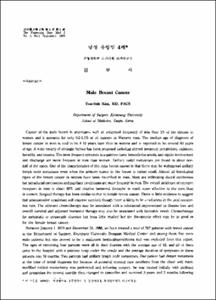남성 유방암 4례
- Keimyung Author(s)
- Kim, You Sah
- Department
- Dept. of Surgery (외과학)
- Journal Title
- Keimyung Medical Journal
- Issued Date
- 1989
- Volume
- 8
- Issue
- 1
- Abstract
- Cancer of the male breast is uncommon with an estimated frequency of less than 1% of the disease in women and it accounts for only 0.2-1.5% of all cancers in Western men. The median age of diagnosis of breast cancer in men is said to be 8-10 years later than in women and is reported to be around 60 years of age. A wide variety of etiologic factors has been proposed including altered hormonal metabolism, radiation, heredity, and trauma. The most frequent symptom is painless lump beneath the areola, and nipple involvement and discharge are more frequent in men than women. Axillary nodal metastases are found in about one-half of the cases. One of the characteristics of the male breast cancer is that there may be widespread axillary lymph node metastasis even when the primary tumor in the breast is rather small. Almost all histological types of the breast cancer in women have been described in men. Most are infiltrating ductal carcinomas but intraductal carcinomas and papillary carcinomas are more frequent in men. The overall incidence of estrogen receptors in men is about 80% and ablative hormonal theraphy is much more effective in the men than in women. Surgical therapy has been similar to that in female breast cancer. There is little evidence to suggest that postoperative irradiation will improve survival, though there is likely to be a reduction in the local recurrence rate. The adjuvant chemotherapy may be associated with a substantial improvement in disease free and overall survival and adjuvant hormonal therapy may also be associated with favorable result. Chemotherapy for metastatic or inoperable diseases has been little studied but the therapeutic effect may be as good as for the female breast cancer. Between January 1, 1979 and December 31, 1988, we have treated a total of 317 patients with breast cancer in the Department of Surgery, Keimyung University Dongsan Medical Center and among them five were male patients but one proved to be a mailgnant hemangiopericytoma and was excluded from this report. The ages of remaining four patients were all in their fourties with the average age of 45, and all of therm came to the hospital with a painless lump under the areola and the average duration of symptoms in these patients was 19 months. Two patients had axillary lymph node metastases. One patient had distant metastasis at the time of initial diagnosis but because of potential nursing care problems from the chest wall mass, modified radical mastectomy was performed and following surgery, he was treated initially with picibanil and prospidine for several months then changed to tamoxifen and survived 3 years and 3 months following surgery. The other patient who had axillay metastasis underwent modified radical mastectomy followed by adjuvant. chemotherapy and he is presently still on the adjuvant chemotherapy. Two patients without lymph node metastasis are alive 4 years and 4 months and 1 year respectively without any sign of local or systemic recurrence.
- Alternative Title
- Male Breast Cancer
- Keimyung Author(s)(Kor)
- 김유사
- Publisher
- Keimyung University School of Medicine
- Citation
- 김유사. (1989). 남성 유방암 4례. Keimyung Medical Journal, 8(1), 200–205.
- Type
- Article
- Appears in Collections:
- 2. Keimyung Medical Journal (계명의대 학술지) > 1989
1. School of Medicine (의과대학) > Dept. of Surgery (외과학)
Items in Repository are protected by copyright, with all rights reserved, unless otherwise indicated.
